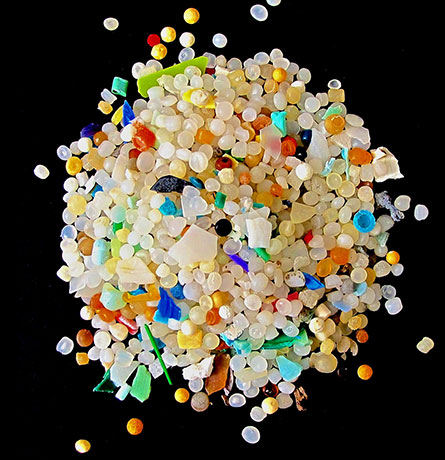
Plastic soup, anyone?
Have you ever heard of garbage island, a giant platform of plastic flotsam of human
waste floating in the Pacific Ocean? Well, it doesn't exist. While it is true that large pieces
of plastic end up in the ocean, the true garbage island can't be seen because it is
suspended in the ocean as microplastics. This product of human success not only
damages aquatic life out in the ocean, but also threatens our health, here in the city!
Microplastics
So what are these so-called microplastics? They are defined as pieces of plastic smaller than 5
mm. One source of these plastics is coming from industries that use plastics in their
processes. Their waste water contains small plastic pellets, the raw material that
manufacturers use to melt into their desired products(1). You can see what they look like in Figure 1.

Figure 1:
Different shapes of microplastics are shown here. The small spherical ones (mostly white) are plastic pallets used by the plastic industry.
Source.
Microplastics wind up in the ocean because they bypass the filtration systems due to their
size(1). Another, rather surprising source of microplastics is in the form of microspheres in
cosmetic products. Many exfoliators, cleansers and facial scrubs make use of microplastics.
These are washed down the drain and into the sewers after usage(2;3). Yet again many filtering
systems fail to extract them from the water. However, the largest source of microplastics are in
fact macroplastics(1). Since plastics are not biodegradable and cannot be recycled into the
building blocks of marine life, they accumulate in the water(4). If the plastics stay afloat, sunlight
can degrade them to some extent, by a process called photodegradation, but does not really
solve the problem. The plastic is not converted into another compound, but simply broken up
into smaller chunks: microplastics(1).
Gyres
But isn't it kind of strange that our urban waste ends up in the middle of the Pacific ocean? It
can all be explained by the existence of gyres, giant swirling currents, moving the water in the
Pacific in a circular motion, thereby trapping many materials in its enormous whirling masses(1).
These gyres cause the plastics to accumulate in one point. They are caused by Earth's rotation,
global wind patterns and Earth's landmasses(5). As you can see in figure 2 there are many
more gyres that can trap macro- and microplastics.

Figure 2:
Ocean gyres all around the world. Giant vortices are created when different gulf streams meet.
Source.
Toxic soup
The plastic soup, a more appropriate name than garbage island, has severe effects on many
lifeforms on earth. The biggest concern about microplastics is their toxicity. Plastics act as toxin
sponges. The smaller the microplastics are, the more surface area is available to adsorb toxins
like bisphenol A, phthalates, POPs (persistent organic pollutants) and then some(1;4). They are
all molecules that impair animal health in one way or another, through induction of birth defects,
reproductive failure or even cancer(1).
Going along the food chain
But why should we worry? I will tell you why: these toxins are bio-accumulators. They cannot be
converted into readily assimilable molecules through the action of living organisms(1). Plankton,
life forms right at the bottom of the food chain, have been reported to ingest microplastics(6). The particles remain in their bodies, along with the toxins attached to them. When fish eat
plankton, they ingest these plastics and toxins as well. As the microplastics climb up the food
chain, more and more of these POPs and other toxins accumulate in all kinds of marine life.
Eventually, the plastics and their bound toxins end up on our plates(1)!
Plastic beach
As a solution beach clean-ups are proposed, because macroplastics degrade most drastically
when fully exposed to sunlight, as is the case on beaches. However, this would be more like
damage-control than an actual solution(1). Also, by trying to recycle most of the plastic
products, or replacing them with more sustainable alternatives like bioplastics. The best way of
course, would be to totally turn around our modern industries, but whether that is feasible is
debatable. further damage can be reduced. However, we have to learn to live with the fact that
most of the plastic that is suspended in the ocean, will never be degraded and will stay in the
ocean forever. So let that sink in for a bit and think of the consequences our urban life has on
the Pacific and on us living in our beloved cities...
You might also enjoy:
-Our article on garbage in the city, which partly focusses on plastic waste management.
-A documentary on what you might encounter when you actually enter the North Pacific gyre.
-This website contains a list of products that do use microbeads.
-This website contains a list with companies that have pledged not to use microbeads in their products.




